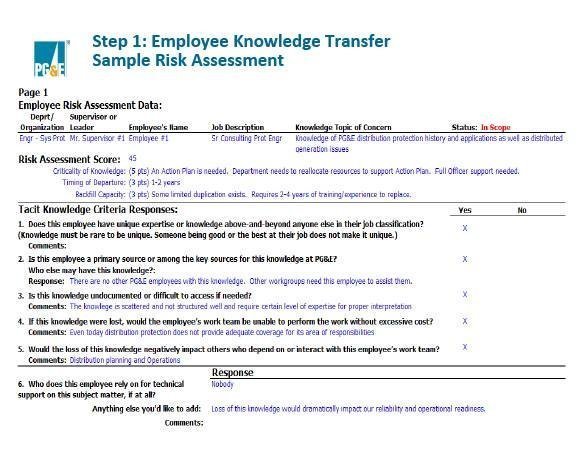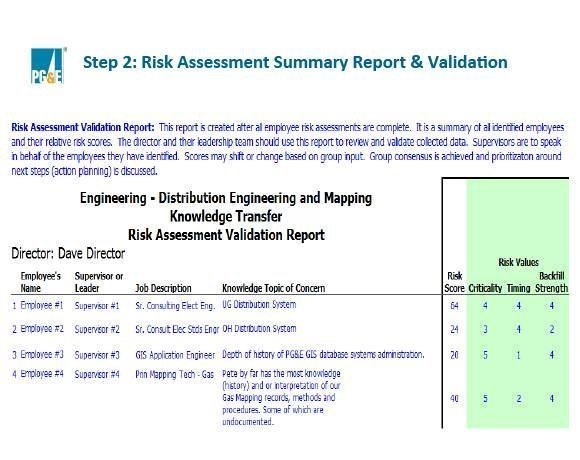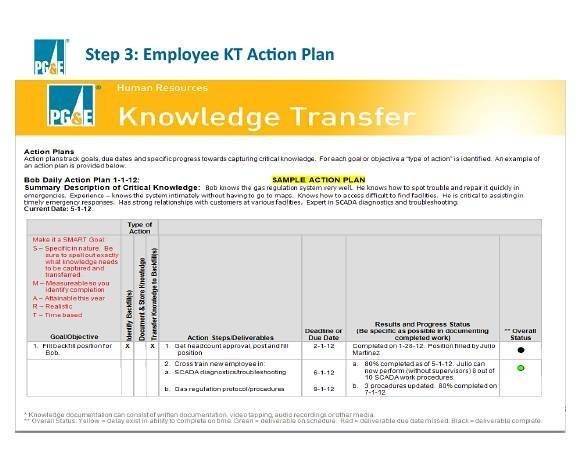Knowledge management strategy helps gas company retain worker know-how
Pacific Gas and Electric shares advice on how to hold on to institutional knowledge when highly experienced workers hit retirement age.
When a Pacific Gas and Electric lineman retires, a fair amount of experiential wisdom goes out the company's doors. Without that knowledge, a replacement can swamp a service truck or get shot at by an angry rancher when driving down the wrong fire road to get to a faulty substation.
That's right: shot at. The wide open spaces in some parts of California still require a certain frontier wisdom to navigate safely. And we're not just talking je ne sais quoi.
More about knowledge management strategy and processes
Watch a short video about Deloitte's efforts in knowledge sharing among workers
Read about how content analytics can help a knowledge strategy
Watch an interview with John Seely Brown about knowledge flow in organizations
To prevent those scenarios and help avoid countless others, Pacific Gas and Electric Corp. of San Francisco has developed a knowledge management strategy aimed at heading off the loss of a significant trove of knowledge packed into the minds of its older baby boomers. A wave of pending retirements over the next several years, representing almost half its current workforce of 21,000, prompted the company to designate the potential loss of a significant amount of collective information as a "topic of concern" back in 2009. Now, it is working to make sure its workers' tacit knowledge gets passed on.
That knowledge management pickle -- how to retrieve collective intelligence and make it reusable for younger and newer employees -- represents a challenge currently being faced by many organizations as baby boomers, a full 43% of the U.S. workforce, started reaching retirement age in 2011. The wave of retirements is expected to peak in 2020 and continue for another decade after that.

PG&E uses a step-by-step process to identify employees nearing retirement who might have valuable 'tribal knowledge' that would prove a risk to lose.
For Pacific Gas and Electric (PG&E), this means that in the next three to five years, up to 45% of its employees will be eligible to begin drawing from retirement packages. That's doubly important for PG&E because "it takes at least three to five years to train someone to take an electric lineman's position," said Kent Lamb, employee development manager at PG&E. Gas line techs and electric linemen make up 27% of PG&E's workforce.
When someone new is hired at the natural gas and electric utility as a lineman, they typically spend three years as an apprentice before earning the position of journeyman. By then, they've gotten the technical know-how required to go out into the field and fix broken lines, leaks and transformers, but they're not as seasoned as someone who's been working, say, for 30 or even 15 years. Lamb said the relative lack of experience can have a negative impact on team productivity, the reliability of the company's service to customers and the safety of its employees.

This image illustrates a sample risk assessment supervisors are asked to fill out about employees nearing retirement age.
Lamb, who has spoken about PG&E's knowledge management strategy at technology conferences, said the kind of information the company is looking to share before someone leaves the company is tacit knowledge that is difficult to pin down.
"It's not documented and it's unique," Lamb said, "Some people call it 'tribal knowledge,' but it's the kind of knowledge that needs to be shared."
Identifying tacit knowledge
Explicit knowledge is the type of information that is typically regarded as "the what" that can be delivered in classrooms, and through books and online. Tacit knowledge is "the how" you typically glean over time from real-world experience and one-on-one sessions with a master of a particular art or skill.

A summary of the individual's risk assessment is weighted and scored to determine how pressing their individual case is to the organization.
"The challenge is, how do we get it out of the individual, how do we mine it and put it into a format that is easy to reuse?" Lamb said. "Sometimes it's in their head, personal notes or on a smartphone."
For example, knowing how to get in and out of a remote location or which fork in the jeep trail to take after a heavy rainstorm can be a safety issue. This "intimate tribal knowledge of the area" is just one kind of knowledge PG&E wants to make available to its workers.
PG&E executives also found themselves at risk of losing expertise in unique procedures, systems information, vendor and manufacturer contacts, methods of diagnosis, and complex troubleshooting. To help prevent that loss, the company assembled a team to figure out how those risks could be mitigated. The group started digging into developing an enterprise knowledge management strategy by polling other companies, such as Chevron, about their related plans, Lamb said.
Grading critical risks
PG&E's human resources department uses IBM's SPSS software that tracks employee age, their tenure as an employee and when they become eligible for retirement. It can also show probable attrition trends and "all kinds of values and factors," which include an estimated value of 401(k) plans, how many children live at home and how many are in college, Lamb said. It helps pinpoint where workforce development plans are most critical. It took the team about five months to design a form that departmental managers could fill out for each employee.

An action plan is designed for the employee so his or her knowledge can be transferred to another employee or recorded in a way that can be consumed or reused.
Supervisors completed the "risk assessments" in the workgroups that they felt had critical knowledge for the organization. The form reviews 10 types of knowledge, and supervisors are asked to complete assessments every 18 months. They grade three major categories: criticality of the knowledge, the employee's timing of departure and the backfill strength of the individual, which indicates their ability to step into another expert's shoes and fill in, in the event of a crisis or absence.
"What we're asking supervisors to do is a bit out of their forte," Lamb said. He suggested that an organization would be well-served if it had "experienced knowledge management practitioners to do the heavy lifting." His department helps supervisors document the assessments so he can then identify the individuals who should be presented with an individual action plan.
"This is just goal-setting 101," Lamb said. "There's nothing magic about this." He said the assessments result "in a nice summary of the people in your organization who you ought to do some work with." The key is then setting up very specific goals with the people who hold that key tacit knowledge.
Getting the individual to then record their knowledge is the next step in the knowledge management strategy.
"You need to stroke their ego a little bit," he said. "Encourage them to leave behind a legacy."
Updating and creating knowledge content
The ways in which they do that include correcting and updating instructional manuals, and creating new "knowledge notebooks," which older employees are encouraged to keep. The company has also instituted mentoring programs and rotational assignments so younger workers can glean knowledge through observation. PG&E is also developing new online training materials written by its baby boomer population.
"We then monitor the progress," Lamb said, "and provide summary reports to upper management and track the results."
While no hard numbers were available, Lamb said that, on a case-by-case basis, supervisors have said things like, "'Hey I can breathe easier now.' And they can point to training that has taken place and have told us they can distribute work among people more evenly as a result."
Social media to play an important role
Lamb said PG&E uses SurveyMonkey for its online risk assessment. He called the product "a little cumbersome" and said he'll often download the survey information into an Excel file to track results and create action plans for individual employees. Supervisors and other interested parties use Microsoft SharePoint to track the employee action plan progress.
Lamb said the human resources department had begun a Microsoft Yammer pilot program to add an enterprise social dimension to the overall knowledge gathering program. Yammer is Microsoft's enterprise social network software.
"I would love to see the company grow in these areas," Lamb said. "social media is a growth opportunity for us. It's going to be highly critical that we -- as a company -- come up to speed on social media. It's what the upcoming generation wants."
About the author:
Jonathan Gourlay is the site and news editor for SearchContentManagement.com. You can reach him at [email protected] and find him on Twitter @sContentMgmt_TT.






